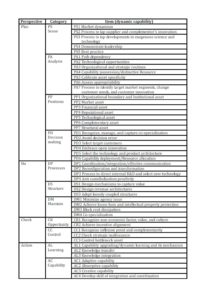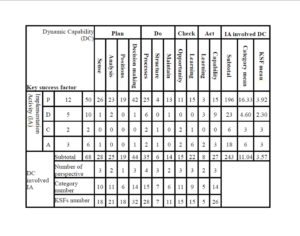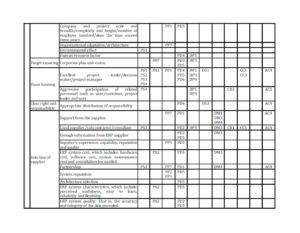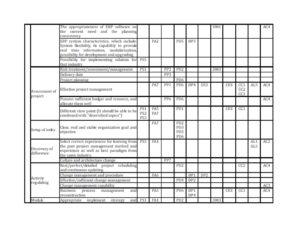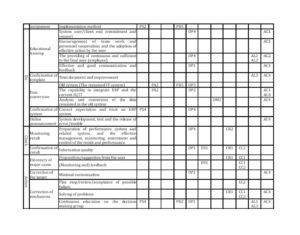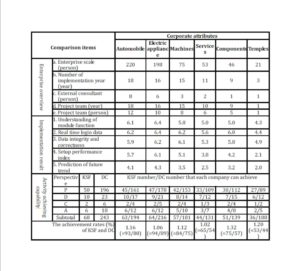With the advancement and popularization in information technology, enterprises are encountering a dramatically changing environment. Therefore, many scholars propose the concept of dynamic capability to assist enterprises maintain a long-term competitive advantage. Teece et al (1997), based on resource point of view, believes that dynamic capability can cope with rapid changes of environment through integrating, setting, and redeploying enterprises’ internal and external resource. In learning side, Eisenhardt and Martin (2000) consider dynamic capability as the internal evolution while enterprise using all kinds of action to deal with market change, and generate new competitive advantage, then enhancing the capability to innovate and develop. Wang and Ahmed (2007) view in the capability perspective, believe that dynamic capability is a deployment, creation and capability, which can gradually improve during enterprises modifying competitive advantage according to market change. Teece (2007) has redefined dynamic capability as enterprises’ intangible asset to effectively deploy resource, and maintaining business long term advantage.
ERP Implementation Stage Process and Key Successful Factors
Undeniably, the ERP system can bring many benefits, but its implementation activity is fraught with risk. Therefore, many scholars had proposed ERP implementation process which can assist enterprises to establish a clear policy (Chien and Tsung, 2009). Umble et al (2003) based on the view point of user, to emphasize the importance of organizational adaptation and education. In process perspective, Hallikainen et al (2009) proposed staged process to illustrate the importance of consistency between process and system. However, the implementation activity requires many resources, so many scholars propose KSFs to assist enterprise controlling the key point (Bueno and Salmeron, 2008; Shafaei and Dabiri, 2008; Kronbichler et al, 2009; Hakim and Hakim, 2010).
Qualitative Interview Method
To achieve the objective, this research adopts 3 qualitative interview methods, because it can effectively summarize experts’ opinions, and find clear causality. (1) KJ method can find the correlation between chaotic factors, and clustering them into a group (Kawakita, 1991). Therefore, KJ method not only assists enterprise to classify and rename the clustered group from certain data, but set up the structural architecture and the level of subject. The implementation processes include 5 steps (Cheng and Leu, 2011).
(2) Focus group interviews method is a congregate discussion, which is concerning on special topics, and communicate with numerous experts and scholars. Meanwhile, it can generate a complete and implementable result through selecting, confirming, suggesting, and correcting consensus with experts (Krueger, 1994). Furthermore, Lin and Wang (2011) used the method to acquire experts’ consensus, and set up a selection model so as to find appropriate software system. The implementation processes of this method include 8 steps (Stewart et al, 2007).
(3) Delphi method can acquire experts’ consistent opinion through distributing expert questionnaire several times. Therefore, it not only can help experts to revise and confirm the result, but ensure all participants present its opinion comprehensively, and free from other experts opinion (Steinert, 2009). Hence, Huang et al (2004) applied this method to carry out 3 questionnaire surveys, and acquired 28 risk factors in the ERP implementation project. The implementation processes include 8 steps (Zolingen and Klaassen, 2003).
Dynamic Capability Model of KFSs
In order to make KSF more useful and valuable during implement ERP, this research follows Gilbert’s (2005) opinions, then set up “dynamic capability model of KSFs” for implementation of ERP activities through combining professional consensus, dynamic capability, and key factors. Hence, this research will obtain the following 3 results: (1) dynamic capability architecture; (2) KSFs and its appropriate position; (3) dynamic capability model of KSF. However, due to experts, professional opinions and complicated causality are required for the result; this research will adopt the following 3 qualitative interview methods: (1) KJ method; (2) Focus group interviews; (3) Delphi method.
To ensure the rationality of implemented process and result of these 3 methods, this research adopts following 4 principles in overall research process: (1) execute KJ method with a professional management consultant through 5 steps proposed by Cheng and Leu (2011); (2) held focus group interview with 3 experienced ERP consultants and 2 scholars through 8 steps proposed by Stewart et al (2007); (3) implement Delphi questionnaire survey with 5 ERP consultants, 3 scholars, and 5 enterprise ERP implementation project directors through 8 steps proposed by Zolingen and Klaassen (2003); (4) invite a professor who had experienced in teaching dynamic capability and practices.
Dynamic Capability Architecture
Enterprise can continuously improve and accumulate experience in ERP implementing through practicing Plan-Do-Check-Action management cycle and ISO (International Organization for Standardization) standards, then achieving goal with cultivating vitality and enhancing core competitiveness (Chien et al, 2002). Therefore, this research will build the dynamic capability architecture through following the process: (1) based on PDCA cycle to redefine the categories and item of dynamic capability; (2) summarize the 8 categories and 52 items (dynamic capability) from 5 dynamic capability related papers; (3) To integrate dynamic capability item from different researches into PDCA cycle, this research classify the above 8 dynamic capability categories and 52 items into PDCA dimensions through KJ method; (4) Then, this research based on the attribute of each cluster, to defines the name of each category, and perform focus group interview method to confirm the rationality of the above research result. However, the meaning of PDCA management cycle still cannot be fully described by the 8 categories. Thus, according to experts and scholars’ comments, this research adding 3 categories, and combining 8 items into 4 items, then set up dynamic capability architectural prototype, which contains 4 dimensions, 11 categories and 48 items; (5) This research conduct the first Delphi questionnaire (Likert 5 scale) survey to confirm the rationality of this prototype; (6) This research examines the consistency among all items in questionnaire through Quartile Deviation (Q) method and judgment criteria proposed by Faherty (1979); (7) Furthermore, while the overall consistency of questionnaire>70%, it means an adequate experts’ consensus is generated (Murray and Hammons, 1995); (8) distributes the second Delphi questionnaire survey in the next week to ensure the overall consistency >70%; (9) Finally, once the item’s score ≧3.5, it implies the appropriateness of questionnaire items is sufficient (Likert, 1932).
With the above procedure, this research received all 13 completed Delphi questionnaires in the first stage. And, this results presents: (1) 16 dynamic capability items are highly consistent (Q≦0.6); (2) 23 dynamic capability items are fairly consistent (0.6≦Q≦1); (3) 9 dynamic capability items are poorly consistent (Q>1). Hence, the overall consistency (high and medium consistency) of the questionnaires is achieving 81.4% (=39/48). Although the overall consistency of Delphi questionnaire in the first stage had exceeded 70%, which is fitting the criteria suggested by Murry and Hammons (1995), but this research still carried out the second Delphi questionnaire survey in next week. The second Delphi survey result says: (1) 24 items are highly consistent; (2) 18 items are fairly consistent; (3) 6 items are poorly consistent. Hence, the overall consistency is 87.5% (=42/48). At the same time, the mean of each item in the survey questionnaire is ≧3.5, which achieve the standard proposed by Likert (1932). Consequently, this research establish the dynamic capability architecture (as shown in Table 1), which is rational and reliable through comprehensively examining.
KSFs and Its Appropriate Location
Additionally, to place KSFs (hereafter abbreviated as “factors”) into each stage of implementation process, this research (1) try to integrate factors which has similar definition, then combining 187 ERP factors into 79 factors by implementing KJ method; (2) this research has complied experts’ opinion in focus group interview, to combine 8 similar items into 4 items, eliminate 2 inappropriate factors, and obtain 73 (=79-6) factors; (3) then, this research had classified the 73 factors to 3 stages: (a) before implementation; (b) during implementation; (c) after implementation, which describe a casual priority in the process of implementation activity. Furthermore, to confirm the rationality of result, this research has performed two stages of Delphi questionnaire survey. The first survey contains 13 questionnaires, which shows: (1) 28 factors are highly consistent; (2) 28 factors are fairly consistent; (3) 17 factors are poorly consistent. Hence, the overall consistency of the survey questionnaire is 76.7% (=56/73). In the second stage, this research acquires: (1) 32 factors are highly consistent; (2) 31 factors are fairly consistent; (3) 10 factors are poorly consistent. Consequently, the overall consistency is 86.3% (=63/73), which is >70%. However, the mean value of 5 factors such as “implementation time” and “software setup” is <3.5, so this research had deleted the 5 factors. Therefore, 68 (=73-5) appropriate and rational factors are obtained.
Although 68 factors of KSFs are categorized into 3 stages, but it still too rough and difficult to be adopted. Thus, this research invites 5 experienced ERP consultants to carry out focus group interview. Through these ERP consultants compared the 5 ERP implementation related papers (Parr and Shanks, 2000; Rajagopal, 2002; Umble et al, 2003; Esteves and Bohorquez, 2007; Chien and Tsung, 2009), they says the result proposed by Chien and Tsung (2009) is more practical, because which is found based on PDCA management cycle, to establish 25 implementation category. It not only draws a detailed implementation map, but help enterprise to figure out the causality of each implementation factor. Therefore, this research is referring the architecture to allocate the categories of 68 factors.
After performing twice KJ method, this research transposes 68 factors into appropriate locations of 22 categories. And, this research holds focus group interviews to confirm the rationality of the result. During interviewing, experts only adjusts the categories of 4 factors, but doesn’t increase or decrease factors. Moreover, this research will implement the second twice Delphi questionnaire survey, to confirm the rationality of each factor location. The first questionnaire survey result reveals: (1)18 items are highly consistent; (2) 39 items are fairly consistent; (3) 11 items are poorly consistent. Hence, the overall consistency is 83.8% (=57/68). Sequentially, the second questionnaire survey result shows: (1) 23 items are highly consistent; (2) 37 items are fairly consistent; (3) 8 items are poorly consistent. Consequently, the overall consistency is 88.2% (=60/68). In the meantime, the mean values of all question items are ≧3.5 (meet the standard). Hence, the attribution locations of 68 KSFs in this research are appropriate and rational through carefully confirming (in Table 2).
The Dynamic Capability Model of KSFs
In order to set up “dynamic capability model of KSFs”, this research aims to blend KSFs and dynamic capability concepts, then (1) propose the correlation of 68 KSFs and 289 dynamic capability by conducting KJ method; (2) deletes 35 dynamic capabilities items depend on the consensus from focus group interviews. Therefore, this research acquires 254 dynamic capability items as an initial result; (3) to confirm the rationality of focus group interview result, this research will perform twice Delphi questionnaire survey in following stages.
In the result of the first stage of questionnaire survey, this research acquired 64 items of high consistency, 143 items of medium consistency, and 47 items of non-consistency. Hence, the overall consistency is 81.5% (=207/254). Although the overall consistency is sufficient (≧70%), but this research still conduct the second Delphi questionnaire, to double-check the reliability. The second Delphi result presents: (1) 108 items are highly consistent; (2) 107 items are fairly consistent; (3) 39 items are poorly consistency. So, the overall consistency is 84.6% (=215/254). Among them, because the mean values of 11 dynamic capability items are <3.5 (lower than the judgment standards), so this research had delete the 11 items. Now, this research has acquired 243 reliable and rational dynamic capability items (in Table 2).
In Table 2, the left side is 4 dimensions and 22 categories proposed by Chien and Tsung (2009). Then, the 68 KSFs are included in categories. Additionally, the dimensions and categories in Table 2 are retrieved from the top of Table 1. Furthermore, the crossover points between the KSFs and the dynamic capabilities are the essential dynamic capability while enterprises aim to achieve the KSFs. Also, the serial numbers are filled in each crossover point is the body of Table 1.
The implication of the Dynamic Capability Model
In Table 2, each ERP implementation stage contains obviously different amount of dynamic capability categories, items, and KSFs, which is shown in Table 3 “Dynamic capability model of KSFs”. For instance, the Plan dimension contains 12 categories, 50 KSFs, 196 items, which acquire high score of KSF capability mean (3.92=196/50). This means once enterprises aim to implement the Plan dimension, which is (1) the most complicated part during implementing ERP; (2) requires many attentions, careful operation and treatment by the enterprise supervisor; (3) requires great efforts of manpower and resource; (4) needs many dynamic capability. Furthermore, this result says the Plan dimension may dramatically influence the ERP implementation activity, which was consistent with the research result proposed by AL-Hudhaif (2012).
Additionally, in dynamic capability, the “processes capability” in Do dimension involves 4 dimensions and 15 categories, which is the most active dynamic capability category obviously in the entire implementation process. Moreover, the “decision making” under Plan dimension contains 32 KSFs number of “DC involved IA”, and 42 dynamic capabilities number of “implementation activity”. So, the “decision making” capability category (1) can help the enterprise to achieve the large amount of KSFs; (2) feature giant effect within the processes activity. Hence, the “decision making” capability category needs many supporting and efforts from the top management. Furthermore, because following 4 categories (processes, sense, capability, analysis) containing relatively more “subtotal number of DC involved IA”, which imply they are crucial, so enterprise can set them as core education training items.
Table 2: Number distribution of implementation activity and dynamic capability
In order to understand the correlation among all items of “enterprise overview”, “implementation result”, and “the achievement rates (%) of KSF and DC”, this research performed paired test through applying Spearman’s Rho coefficient, which says (1) in “enterprise overview” section, the correlation coefficient and significance between “external consultant” and KSF number, or DC number is relatively poor (0.882** and 0.841**); (2) in “implementation result”, the correlation coefficient and significance between “data integrity and correctness” and KSF number or DC number is relatively poor (0.899**, 0.943**); (3) the correlation coefficient between KSF number and DC number is 1.000***; (4) the correlation coefficient and significance between “enterprise overview” and KSF number or DC number is lower than “implementation result”, but still remains highly positive.
This means (1) the “external consultant number” only has lower effect to achieve KSF and DC; (2) “data integrity and correctness” also hard to influence enterprises to achieve the KSF and DC; (3) while an enterprise achieving more KSF number, it will feature more DC number; (4) “implementation result” has much stronger effect on achieving KSF and DC compared to “enterprise overview”.
To figure out the correlation difference between multiple factors, this research aims to conduct Kendall’s W test, which calculates concordance coefficients (W), and presents the following result: (1) in “implementation result”, the “W” equals to 0.901***; (2) “Project team (person)”, “DC number”, and 5 parts of “Implementation result” featuring relatively lower correlation coefficient with “Enterprise overview” (W=0.800***). This implies that: (1) during the ERP activity process, the 5 scopes may influence others scope as well; (2) the “project team (person)” featuring weaker importance degree while “implementation result” and “DC number possessed by an enterprise” are considered as well.
Furthermore, this research found the correlation between “project team (person)” and “DC number possessed by an enterprise” is stronger than the “external consultant number”. However, if “implementation result” is taken into consideration, the correlation would be worse. This indicates: (1) when project team contains more members, it is helpful to achieve DC; (2) once the “external consultant number” is fewer, the “implementation result” and the possession of such enterprise’s DC number will become fewer also.
Management implication
So, this research interviewing with enterprises’ directors, and structures this result of case study, which not only verifies the practical value of this research, but provides the following 3 aspects of management implication: (1) in management application aspect, the enterprises can (a) inspect the insufficiency of ERP implementation activity and improve project management action through reviewing PDCA management, KSFs categories, and items; (b) effectively set up the training direction of organizational dynamic capability through applying dynamic capability architecture; (c) discover risk and abnormity in advance, and find the weak dynamic capability, then prevent accidents occurrence; (d) examine the capability of ERP project team and consultant based on the result; (2) in management mechanism aspect, the enterprises can (a) reinforce the operation mechanism of ERP implementation project activity; (b) establish the resource distribution mechanism for project activity through realizing key success factors; (c) correct training guideline and its operation mechanism; (d) set up the performance assessment mechanism for ERP project team and consultant through this model; (3) in management decision making aspect, the enterprises can (a) make reasonable resource allocation on each department and different ERP implementation stage; (b) propose well-designed appropriate human resource development strategy and decision, which could enhance the essential dynamic capability of ERP implementation activity; (c) indicate an appropriate guideline and resource adjustment decision to accelerate the effectiveness of ERP implementation activity.
Conclusions
In the past, although lots of scholars have proposed research results related to the KSFs, when enterprise directors are applying these conceptual guidelines and suggestions, they often fail to correctly seize necessary actions and required capabilities during the implementation process. Moreover, since the entire implementation is a dynamic and changeable process for project activity, enterprises frequently fail to obtain the ERP implementation benefit from previous research result.
Therefore, this research has (1) converted the perspective and item of dynamic capability into PDCA management cycle, so as to set up a dynamic capability architecture having 4 dimensions, 11 categories and 48 capability items (Table 1); (2) integrated the 4 dimensions and 22 categories (Chien and Tsung, 2009) and 68 KSFs proposed become a referable procedure, which can be implemented and generated more practical value of ERP implementation; (3) integrated dynamic capability architecture and KSF in the PDCA management cycle, then propose “the dynamic capability model of KSF” as shown in Table 2.
To further describe the implication of the model, this research presents the importance degree between different categories or KSFs and then displays important degree and selection basis of each dynamic capability category. Furthermore, this research aims to confirm the rationality and application value of this research result, so conduct case study comparison, which says highly positive correlation between “the achievement rate (%) of KSF and DC”, “enterprise overview”, and “implementation result”. This means the result could assist enterprise to achieve KSFs, enhance dynamic capability, and even successfully implement ERP. Finally, this research has clearly described how to apply this model, and introduce the meaning of this model in management application aspect, management mechanism aspect, and management decision aspect.
This research suggestion following future research directions: (1) consider conditions such as importance, time and resource, then establish criteria for selecting and incubating all kinds of dynamic capability; (2) develop the map of dynamic capability through applying casual path method, and linking the relationship among each dynamic capability.
References
1. AL-Hudhaif, S A. (2012), ‘ERP implementation at King Saud university,’ Global Journal of Management and Business Research, 12 (5), 71-78.
Google Scholar
2. Bueno, S. and Salmeron, J L. (2008), ‘Fuzzy modeling enterprise resource planning tool selection,’ Computer Standards & Interfaces, 30 (3), 137-147.
Publisher – Google Scholar
3. Cheng, Y M. and Leu, S S. (2011), ‘Integrating data mining with KJ method to classify bridge construction defects,’ Expert Systems with Applications, 38 (6), 7143-7150.
Publisher – Google Scholar
4. Chien, T K. and Tsung, H S. (2009), ‘How can we successfully implement the ERP activity’ Proceedings of the IEEE International Conference on e-Business Engineering (ICEBE), ISBN: 978-0-7695-3842-6, 21-23 Oct. 2009, Macau, 295-300.
Google Scholar
5. Chien, T K., Su, C H. and Su, C T. (2002), ‘Implementation of a customer satisfaction program: A case study,’ Industrial Management & Data Systems, 102 (5), 252-259.
Publisher – Google Scholar
6. Eisenhardt, K M. and Martin, J A. (2000), ‘Dynamic capabilities: What are they,’ Strategic Management Journal, 21 (10/11), 1105-1121.
Google Scholar
7. Esteves, J. and Bohorquez, V. (2007), ‘An updated ERP system annotated bibliography: 2001-2005,’ Communications of the Association for Information Systems, 19 (1), 386-446.
Google Scholar
8. Faherty, V. (1979), ‘Continuing social work education: Results of Delphi survey,’ Journal of Education for Social Work, 15 (1), 12-19.
Publisher – Google Scholar
9. Gilbert, J K. (2005) Visualization: a meta-cognitive skill in science and science education, Springer-Verlag, Now York.
Google Scholar
10. Hakim, A. and Hakim, H. (2010), ‘A practical model on controlling the ERP implementation risks,’ Information Systems, 35 (2), 204-214.
Publisher – Google Scholar
11. Hallikainen, P. Kivijarvi, H. and Tuominen, K. (2009), ‘Supporting the module sequencing decision in the ERP implementation process- An application of the ANP method,’ International Journal of Production Economics, 119 (2), 259-270.
Publisher – Google Scholar
12. Huang, S M., Chang, I C., Li, S H. and Lin, M T. (2004), ‘Assessing risk in ERP projects: Identify and prioritize the factors,’ Industrial Management & Data Systems, 104 (8), 681-688.
Publisher – Google Scholar
13. Kawakita, J. (1991), The original KJ Method, Kawakita Research Institute, Tokyo.
Publisher – Google Scholar
14. Kronbichler, S A., Ostermann, H. and Staudinger, P. (2009), ‘A review of critical success factors for ERP-project,’ The Open Information Systems Journal, 3, 14-25.
Publisher – Google Scholar
15. Krueger, R A. (1994), Focus groups a practical guide to applied research, Thousand Oaks, Canada.
16. Likert, R. (1932), ‘A technique for the measurement of attitudes,’ Archives of Psychology, 22 (140), 1-50.
Google Scholar
17. Lin, C W. and Wang, C H. (2011), ‘A selection model for auditing software,’ Industrial Management & Data Systems, 111 (5), 776-790.
Publisher – Google Scholar
18. Murry, J W. and Hammons, J O. (1995), ‘Delphi: A versatile methodology for conducting qualitative research,’ The Review of Higher Education, 18 (4), 423-436.
Publisher – Google Scholar
19. Rajagopal, P. (2002), ‘An innovation–Diffusion view of implementation of enterprise resource planning (ERP) systems and development of a research model,’ Information & Management, 40 (2), 87-114.
Publisher – Google Scholar
20. Shafaei, R. and Dabiri, N. (2008), ‘An EFQM based model to access an enterprise readiness for ERP implementation,’ Journal of Industrial and Systems Engineering, 2 (1), 51-74.
Publisher – Google Scholar
21. Shanks, G. (2000), ‘A model of ERP project implement,’ Journal of Information Technology, 15 (4), 289-303.
Publisher – Google Scholar
22. Steinert, M. (2009), ‘A dissensus based online Delphi approach: An explorative research tool,’ Technological Forecasting and Social Change, 76 (3), 291-300.
Publisher – Google Scholar
23. Stewart, D W., Shamdasani, P N. and Rook, D W. (2007), Focus groups: Theory and practice, Thousand Oaks, Canada.
Publisher – Google Scholar
24. Teece, D J. (2007), ‘Explicating dynamic capabilities: The nature and microfoundations of (sustainable) enterprise performance,’ Strategic Management Journal, 28 (13), 1319-1350.
Publisher – Google Scholar
25. Teece, D J., Pisano, G., Shuen, A. and Shuen, A. (1997), ‘Dynamic capabilities and strategic management,’ Strategic Management Journal, 18 (7), 509-533.
Google Scholar
26. Umble, E J., Haft, R R. and Umble, M M. (2003), ‘Enterprise resource planning: Implementation procedures and critical success factors,’ European Journal of Operational Research, 146 (2), 241-257.
Publisher – Google Scholar
27. Wang, C L. and Ahmed, P K. (2007), ‘Dynamic capabilities: A review and research agenda,’ International Journal of Management Reviews, 9 (1), 31-51.
Publisher – Google Scholar
28. Zolingen, S J V. and Klaassen, C A. (2003), ‘Selection processes in a Delphi study about key qualifications in senior secondary vocational education,’ Technological Forecasting & Social Change, 70 (4), 317-340.
Publisher – Google Scholar



